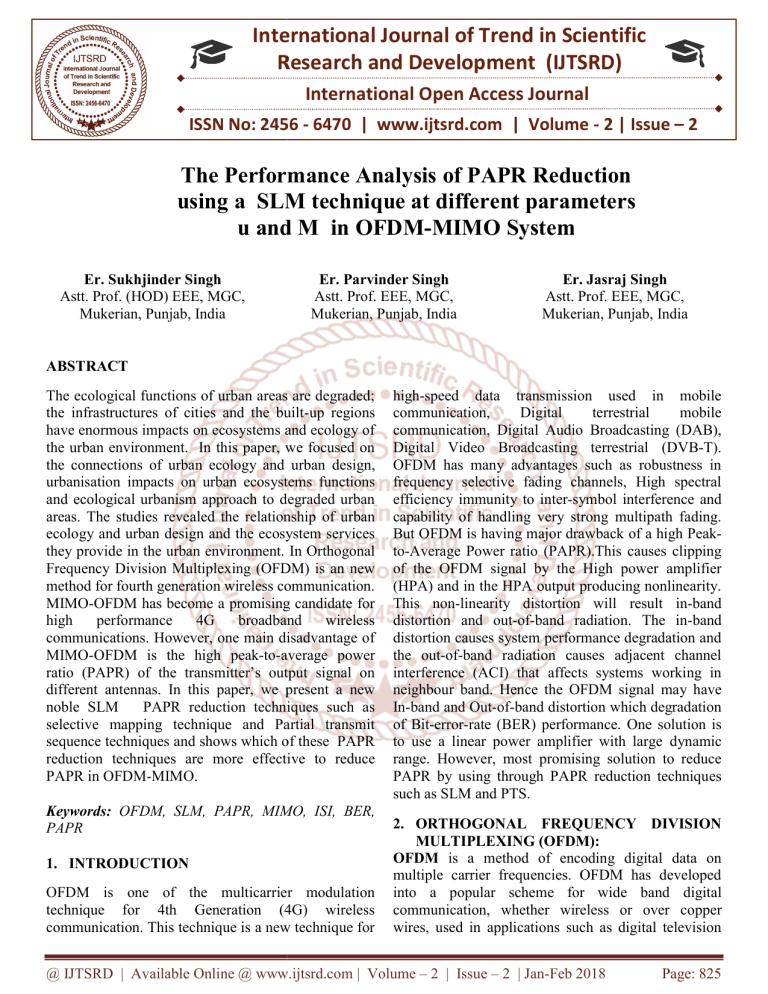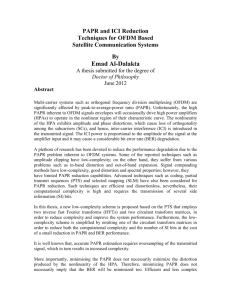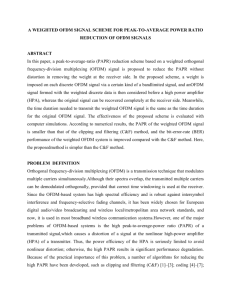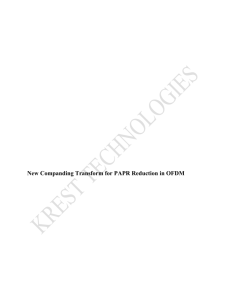
International Journal of Trend in Scientific
Research and Development (IJTSRD)
International Open Access Journal
ISSN No: 2456 - 6470 | www.ijtsrd.com | Volume - 2 | Issue – 2
The Perform
Performance
ance Analysis of PAPR Reduction
using a SLM te
technique
chnique at different parameters
u and M in OFDM-MIMO
MIMO System
Er. Sukhjinder Singh
Astt. Prof. (HOD) EEE, MGC,
Mukerian, Punjab, India
Er. Parvinder Singh
Astt. Prof. EEE, MGC,
Mukerian, Punjab, India
Er. Jasraj Singh
Astt. Prof. EEE, MGC,
Mukerian,
Mukerian Punjab, India
ABSTRACT
The ecological functions of urban areas are degraded;
the infrastructures of cities and the built
built-up regions
have enormous impacts on ecosystems and ecology of
the urban environment. In this paper, we focused on
the connections of urban ecology and urban design,
urbanisation impacts on urban ecosystems functions
and ecological urbanism approach to degraded urban
areas. The studies revealed the relationship of urban
ecology and urban design and the ecosystem services
they provide in the urban environment. IIn Orthogonal
Frequency Division Multiplexing (OFDM) is an new
method for fourth generation wireless communication.
MIMO-OFDM
OFDM has become a promising candidate for
high
performance
4G
broadband
wireless
communications. However, one main disadvantage of
MIMO-OFDM is the high peak-to-average
average power
ratio (PAPR) of the transmitter’s output signal on
different antennas. In this paper, we present a new
noble SLM
PAPR reduction techniques such as
selective mapping technique and Partial transmit
sequence techniques and shows which of these PAPR
reduction techniques are more effecti
effective to reduce
PAPR in OFDM-MIMO.
Keywords: OFDM, SLM, PAPR, MIMO, ISI, BER,
PAPR
1. INTRODUCTION
OFDM is one of the multicarrier modulation
technique for 4th Generation (4G) wireless
communication. This technique is a new technique for
high-speed data transmission used in mobile
communication,
Digital
terrestrial
mobile
communication, Digital Audio Broadcasting (DAB),
Digital Video Broadcasting terrestrial (DVB-T).
OFDM has many advantages such as robustness in
frequency selective fading channels, High spectral
efficiency immunity to inter-symbol
symbol interference and
capability of handling very strong multipath fading.
But OFDM is having major drawback of a high Peakto-Average
Average Power ratio (PAPR).This causes clipping
of the OFDM signal by the High power amplifier
(HPA) and in the HPA output producing nonlinearity.
This non-linearity
linearity distortion will result in-band
distortion and out-of-band
band radiation. The in-band
in
distortion causes system performance degradation and
the out-of-band radiation causes adjacent channel
interference (ACI) that affects systems working in
neighbour band. Hence the OFDM signal may have
h
In-band and Out-of-band
band distortion which degradation
of Bit-error-rate
rate (BER) performance. One solution is
to use a linear power amplifier with large dynamic
range. However, most promising solution to reduce
PAPR by using through PAPR reduction techniques
techniqu
such as SLM and PTS.
2. ORTHOGONAL FREQUENCY DIVISION
MULTIPLEXING (OFDM):
OFDM is a method of encoding digital data on
multiple carrier frequencies. OFDM has developed
into a popular scheme for wide band digital
communication, whether wireless or over copper
co
wires, used in applications such as digital television
@ IJTSRD | Available Online @ www.ijtsrd.com | Volume – 2 | Issue – 2 | Jan-Feb
Feb 2018
Page: 825
International Journal of Trend in Scientific Research and Development (IJTSRD) ISSN: 2456-6470
and audio broadcasting, DSL broadband internet
access, wireless networks, and 4G mobile
communications. OFDM is essentially identical to
coded OFDM (COFDM) and discrete multi-tone
modulation (DMT), and is a frequency-division
multiplexing (FDM) scheme used as a digital multicarrier modulation method. A large number of closely
spaced orthogonal sub-carrier signals are used to carry
data. The data is divided into several parallel data
streams or channels, one for each sub-carrier. Each
sub-carrier is modulated with a conventional
modulation scheme (such as quadrature amplitude
modulation or phase-shift keying) at a low symbol
rate, maintaining total data rates similar to
conventional single-carrier modulation schemes in the
same bandwidth. The primary advantage of OFDM
over single-carrier schemes is its ability to cope with
severe channel conditions (for example, attenuation of
high frequencies in a long copper wire, narrowband
interference and frequency-selective fading due to
multipath) without complex equalization filters.
Channel equalization is simplified because OFDM
may be viewed as using many slowly modulated
narrowband signals rather than one rapidly modulated
wideband signal. The low symbol rate makes the use
of a guard interval between symbols affordable,
making it possible to eliminate intersymbol
interference (ISI) and utilize echoes and timespreading (that shows up as ghosting on analogue TV)
to achieve a diversity gain, i.e. a signal-to-noise ratio
improvement. This mechanism also facilitates the
design of single frequency networks (SFNs), where
several adjacent transmitters send the same signal
simultaneously at the same frequency, as the signals
from multiple distant transmitters may be combined
constructively, rather than interfering as would
typically occur in a traditional single-carrier
system.fig1. shows an OFDM spectrum
3. Orthogonality
In OFDM, the sub-carrier frequencies are chosen so
that the sub-carriers are orthogonal to each other,
meaning that cross-talk between the sub-channels is
eliminated and inter-carrier guard bands are not
required as shown in OFDM spectrum. This greatly
simplifies the design of both the transmitter and the
receiver; unlike conventional FDM, a separate filter
for each sub-channel is not required.
4. OFDM TRANSCEIVE STRUCTURE
To generate OFDM successfully the relationship
between all the carriers must be carefully controlled to
maintain the orthogonality of the carriers. For this
reason, OFDM is generated by firstly choosing the
spectrum required based on the input data, and
modulation scheme used. Each carrier to be produced
is assigned same data to transmit. The required
amplitude and phase of them are calculated based on
the modulation scheme. The required spectrum is then
converted back to its time domain signal bin, thus
performing the IFFT using an Inverse Fourier
Transform (IFT). In most applications, an Inverse Fast
Fourier Transform (IFFT) is used.
The IFFT performs the transformation very efficiently
and provides a simple way of ensuring the carrier
signals produced are orthogonal. The Fast Fourier
Transform (FFT) transforms acyclic time domain
signal into its equivalent frequency spectrum. This is
done by finding the equivalent waveform, generated
by a sum of orthogonal sinusoidal components. The
amplitude and phase of the sinusoidal components
represent the frequency spectrum of the time domain
signal. The IFFT performs the reverse process,
transforming a spectrum (amplitude and phase of each
component) into a time domain signal. An IFFT
converts a number of complex data points, of length
that is a power of 2, into the time domain signal of the
same number of points. Each data point in frequency
spectrum used for an FFT or IFFT is called a bin. The
orthogonal carrier required for the OFDM signal can
be easily generated by setting the amplitude and phase
of each frequency.
Fig. 1 OFDM SPECTRUM
@ IJTSRD | Available Online @ www.ijtsrd.com | Volume – 2 | Issue – 2 | Jan-Feb 2018
Page: 826
International Journal of Trend in Scientific Research and Development (IJTSRD) ISSN: 2456-6470
referred to as PAPR, in some literatures, also written
as PAR. It is usually defined as,
𝑃𝐴𝑃𝑅 =
Fig.2. OFDM Transceiver Structure
Fig.2 shows the configuration for a basic OFDM
Transmitter and Receiver.
5. PROBLEM
OF
PEAK-TO-AVERAGE
POWER RATIO IN OFDM SYSTEM
High Peak-to-Average Power Ratio (PAPR) has been
recognized as one of the major practical problem in
OFDM signal. High PAPR results from the nature of
the modulation itself where multiple subcarriers /
sinusoids are added together to form the signal to be
transmitted. When N sinusoids add, the peak
magnitude would have a value of N, Where the
average might be quite low due to the destructive
interference between the sinusoids. High PAPR
signals are usually undesirable for it usually strains
the analog circuitry. High PAPR signals would
require a large range of dynamic linearity from the
analog circuits which usually results in expensive
devices and high power consumption with lower
efficiency (for e.g. power amplifier has to operate
with larger back-off to maintain linearity).
In OFDM system, some input sequences would result
in higher PAPR than others. For example, an input
sequence that requires all such carriers to transmit
their maximum amplitudes would certainly result in a
high output PAPR. Thus by limiting the possible input
sequences to a smallest sub set, it should be possible
to obtain output signals with a guaranteed low output
PAPR.
6. PAPR Definition
Theoretically, large peaks in OFDM system can be
expressed as Peak-to-Average Power Ratio, or
𝑃
𝑃
= 10𝑙𝑜𝑔
max [|𝑥 | ]
𝐸 [|𝑥 | ]
Where 𝑃𝑝𝑒𝑎𝑘 represents peak output power,
𝑃𝑎𝑣𝑒𝑟𝑎𝑔𝑒 means average output power. 𝐸 ∙ denotes
the expected value, 𝑥 represents the transmitted
OFDM signals which are obtained by taking IFFT
operation on modulated input symbols. Mathematical,
𝑥 is expressed as:
For an OFDM system with N sub-carriers, the peak
power of received signals is N times the average
power when phase values are the same. The PAPR of
baseband signal will reach its theoretical maximum at
(𝑑𝐵) = 10log 𝑁. For example, for a 16 sub-carriers
system, the maximum PAPR is 12 dB. Nevertheless,
this is only a theoretical hypothesis. In reality the
probability of reaching this maximum is very low.
7. DIFFERENT
PAPR
REDUCTION
TECHNIQUES
At present, there are many PAPR reduction
techniques of OFDM. Such as Clipping and Filtering,
block coding, Sub block coding technique, Selective
Mapping (SLM), Partial Transmit Sequences (PTS)
Interleaving, Tone Reduction (TR), Tone Injection
(TI). But out of these techniques SLM and PTS
provides the efficient solution for PAPR reduction in
OFDM –MIMO system. symbols. Therefore in the
paper we study only one techniques and study the
performances of SLM PAPR Reduction techniques.
7.1. SELECTIVE MAPPING TECHNIQUE
In selective mapping (SLM) technique the actual
transmit signal lowest PAPR is selected from a set of
sufficiently different signals which all represents the
same information. . In the SLM technique, the
transmitter generates a set of sufficiently different
@ IJTSRD | Available Online @ www.ijtsrd.com | Volume – 2 | Issue – 2 | Jan-Feb 2018
Page: 827
International Journal of Trend in Scientific Research and Development (IJTSRD) ISSN: 2456-6470
candidate data blocks, all representing the same
information as the original data block, and selects the
most favourable for transmission
Block diagram of SLM Technique is shown in Fig.2
Fig. 2: Block Diagram of OFDM transmitter with the SLM Technique
Let.s define data stream after serial to parallel
conversion as
X=[X0, X1--------,XN-1].
(1)
Each data block X=[X0, X1--------,XN-1] is multiplied
element by element with different phase sequences,
each of length N. Initially each input Xnu can be
defined as equation
Xnu = Xn.bnu
Xnu and bu can be written as
Xnu = [ Xou , X1u,...................XN-1u] (2)
bu = [ bu,o , bu,1 ,................... bu,N-1] (3)
Where n = 0, 1, 2-------N-1, and u=0,1,2...U to make
the U phase rotated OFDM data blocks. All U phase
rotated OFDM data blocks represented the same
information as the unmodified OFDM data block,
provided that the phase sequence is known. After
applying the SLM technique, the complex envelope of
the transmitted OFDM signal becomes
X(t)=
√
∑
𝑋 𝑒
⎍ △
o< t < NT (4)
here △f =
, NT is the duration of an OFDM data
block. Output data of the lowest PAPR is selected to
transmit. PAPR reduction effect will be better as the
copy block number U is increased. SLM method
effectively reduce PAPR without any signal
distortion. But it has higher system complexity and
computational burden. This complexity can less by
reducing the number of IFFT block. but this original
SLM techniques don’t give good result in PAPR
reduction. Therefore we use new SLM technique with
sub band permutation scheme in this paper which
give better PAPR reduction results. In this paper we
use Alamouti scheme (STBC) for the MIMO-OFDM
system in the case of two transmitting antenna .we
know that during the first time slot, two OFDM
symbol transmitted from antennas 1 and 2 are given
by, respectively
X1=[𝑋 , 𝑋 -------,𝑋
X2=[𝑋 , 𝑋 -------,𝑋
],
],
(5)
(6)
During the next time slot, complex conjugate - X2 is
transmitted from antenna 1, and X1 is transmitted from
antenna 2. For an MIMO-OFDM system with 2
transmit antennas and N subcarriers . total subcarriers
@ IJTSRD | Available Online @ www.ijtsrd.com | Volume – 2 | Issue – 2 | Jan-Feb 2018
Page: 828
International Journal of Trend in Scientific Research and Development (IJTSRD) ISSN: 2456-6470
are divided into M subbands of equal sizes,
represented as
Xj = [𝑋 , 𝑋 -------,𝑋 ]
(7)
Where j denotes the index of transmit antenna. With
two antennas, after performing Subband Permutation
on the first subblock, we obtain 2 different OFDM
sets of sequences. These are the original set
Then, we find the average PAPR of X1 and X
denote it as mean{ PAPR(X1),PAPR(X2)}.
2
and
After identifying averages for all M2 sequence sets,
we pick a set with the minimum mean
{PAPR(X1),PAPR(X2)} for transmission.
IV. SIMULATION RESULT
and the original set with the first subblock swapped;
To calculate the PAPR performance accurately from
the statistical point of view, the complementary
cumulative distribution function (CCDF) of the PAPR
of the OFDM signals is used to describe the
probability of exceeding a given threshold
PAPR0 , CCDF = Pr (PAPR > PAPR) .
X1 = [𝑋 , 𝑋 -------,𝑋 ]
and
X1 = [𝑋 , 𝑋 -------,𝑋 ]
In a simple approximate expression is derived for the
CCDF of the PAPR of a multicarrier signal
Pr (PAPR > PAPR)= 1-(1-exp(-PAPR0))N.
X1 = [𝑋 , 𝑋 -------,𝑋 ]
and
X2= [𝑋 , 𝑋 -------,𝑋 ]
(8)
(9)
(10)
(12)
Same operations are then performed on all other
subblocks. With Φ M Φ subblocks and 2 antennas,
totally M 2Φ permutated sequence sets can be
obtained. Out of these M 2 sequence sets, based on a
certain criterion, a set ←{X 1, X 2}← with the best
PAPR property is chosen for transmission. Here, we
consider a minimum average (minaverage) criterion.
For each of M 2 sequence sets, we first calculate the
PAPR of X1 and X 2 and denote it as
PAPR(X1), PAPR(X2)
Original SLM Technique
In the results which follow, 105 random OFDM
sequences were generated to obtain the CCDF’s. We
use two transmit antennas and N=64 subcarriers. The
input constellation used is 4-QAM.
Figure 3, Figure 4 and Figure 5 shows, the PAPR vs
CCDF of the the proposed SLM method for the case
of two transmit antennas, for u=4 , and u=6 at
different values of M=2, 4, 6 and 8 respectively.
There are several observations that can be made from
These plots. In the table there is comparison of PAPR
vs CCDF of the the SLM methods for the case of
two transmit antennas, for u=4 and u=6
8.1 dB, for u=4
SLM scheme with subband Proposed SLM technique
permutation
6.3, 6.15 and 6.1,dB, for 5, 3.3 and 2 1.6 dB for M=2,4,6,8
M=2,4,8 at fixed u=4
at fixed u=4
7.6 dB, for u=6
6.1,5.8 and 5.7 dB form=2,4,8 4.2,2.5 and 1.3, 1.0 dB for
at fixed u=6
M=2,4,6,8 at fixed u=6
Firstly, the proposed scheme achieves significantly
better performance than the original SLM scheme and
SLM scheme with subband permutation.
From figure 3, where u is fixed at 2 the PAPR
reduction gain of the proposed method is about 3.5 dB
for M =2 and 6.2dB for M = 4 and 7.4 dB for M = 6
compared with the SLM Scheme. This SLM based
@ IJTSRD | Available Online @ www.ijtsrd.com | Volume – 2 | Issue – 2 | Jan-Feb 2018
Page: 829
International Journal of Trend in Scientific Research and Development (IJTSRD) ISSN: 2456-6470
PAPR reduction gives better performance
compared to others PAPR reduction techniques.
as
Figure 3 (PAPR vs CCDF for different value of M & u=4)
From figure 4, where u is fixed at 4 the PAPR reduction gain of the proposed method is about 3.1 dB for M = 2,
4.8 dB for M = 4 and 6.1 dB for M = 6 and M=8 compared with the SLM techniques.
Figure 4 (PAPR vs CCDF for different value of M & u=4)
@ IJTSRD | Available Online @ www.ijtsrd.com | Volume – 2 | Issue – 2 | Jan-Feb 2018
Page: 830
International Journal of Trend in Scientific Research and Development (IJTSRD) ISSN: 2456-6470
From figure 5, where U is fixed at 6 the PAPR reduction gain of the proposed method is about 3.1 dB for M =
2, 4.8 dB for M = 4 and 6.1 dB for M = 6 and M=8 compared with the SLM
Figure 5 (PAPR vs CCDF for different value of M & u=6)
8. CONCLUSION
The disadvantages of the OFDM systems that is a
high peak to average power ratio, namely the peak
value of some of the transmitted signals could be
much larger than the typical values. PAPR makes the
amplifiers to work in non-linear regions This will
cause inter modulation between the different sub
carriers and introduce additional interference to the
system. Additional interference leads to an increase in
Bit Error Rate (BER).Large PAPR leads to inband
distortion and spectral spreading There are number of
techniques to deal with the problem of PAPR Some of
them are amplitude clipping, filtering, coding, partial
transmit sequence and selected mapping (SLM) and
partial transmit sequences(PTS). In this paper a new
selected mapping method (SLM) is given that
provides good performance for PAPR reduction a
more efficient solution using SLM in combination
with sub band Permutation is proposed for STBC
MIMO-OFDM Systems. The proposed method was
shown to have a 5–7 dB PAPR reduction gain for 2
transmit antennas, compared with the SLM scheme.
To have a better compromise between the complexity
of the system and gain in comparison with the SLM
method, the following value of M=4,6 and 8 can be
used for For u=4 and u=6, M=2 can be used. Our
simulations have demonstrated that, considerable
performance improvement can be achieved by the
proposed PAPR-reduction method and PAPR
reduction using this new SLM technique is better
results as compared with the conventional SLM
scheme
REFERENCES
1. S. HEE HAN, AND J. HONG LEE, “Modified
Selected Mapping Technique for PAPR Reduction
of Coded OFDM Signal” IEEE transactions on
broadcasting, vol. 50, no. 3,september [2004].
2. S. HEE HAN, J. HONG LEE, “an overview of
peak-to-average power ratio reduction techniques
for multicarrier transmission” IEEE wireless
Communications April [2005]
3. R.O'Neill and L. B. Lopes, “Envelope Variations
and Spectral Splatter in Clipped Multicarrier
Signals,” Proc. IEEE PIMRC '95,Toronto,
Canada, Sept. [1995]
4. J. Armstrong, “Peak-to-average power reduction
for OFDM by repeated clipping and frequency
domain filtering,” IEEE vol. 38, no. 5, pp. 246–
247, Feb. [2002].
@ IJTSRD | Available Online @ www.ijtsrd.com | Volume – 2 | Issue – 2 | Jan-Feb 2018
Page: 831
International Journal of Trend in Scientific Research and Development (IJTSRD) ISSN: 2456-6470
5. K. G. Paterson and V. Tarokh, “On the Existence
and Construction of Good Codes with Low Peakto-Average Power Ratios,” IEEE Trans.Info.
Theory, vol. 46, no. 6, Sept. [2000]
16. B. S. Krongold and D. L. Jones, “PAR Reduction
in OFDM via Active Constellation Extension,”
IEEE Trans. Broadcast., vol. 49, no. 3, Sept.
2003, pp. 258–68.
6. B. S. Krongold and D. L. Jones, “An Active-Set
Approach for OFDM PAPR Reduction via Tone
Reservation,” IEEE Trans. Signal Processing, vol.
52, no. 2, pp. 495–509, Feb. 2004.
17. A. D. S. Jayalath and C. R. N. Athaudage, “On the
PAR Reduction of OFDM Signals Using Multiple
Signal Representation,” IEEE Commun. Lett., vol.
8, no. 7, pp. 425–427, July 2004.
7. C. Tellambura, “Computation of the Continuous–
Time PAR of an OFDM Signal with BPSK
Subcarriers,” IEEE Commun. Lett., vol . 5, no. 5,
May 2001, pp. 185–87.
18. S. H. Han and J. H. Lee, “PAPR Reduction of
OFDM Signals Using a Reduced Complexity PTS
Technique,” IEEE Sig. Proc. Lett., vol. 11, no. 11,
Nov. 2004, pp. 887–90.
8. M. Tan, Z. Latinovi´c, and Y. Bar-Ness,“STBC
MIMO-OFDM Peakto-Average Power Ratio
Reduction by Cross-Antenna Rotation and
Inversion,”
IEEE
COMMUNICATIONS
LETTERS, VOL. 9, NO. 7,JULY 2005.
19. Chin-Liang Wang and Yuan Ouyang,“LowComplexity Selected Mapping Schemes for Peakto-Average Power Ratio Reduction in OFDM
Systems,”IEEE transactions on signal processing,
vol. 53, no. 12, december 2005
9. R. van Nee and R. Prasad, OFDM for Wireless
Multimedia Communications, Artech House,
2000.
20. D.S. Jayalath and C. Tellambura, “The use of
interleaving to reduce the peak-to-average power
ratio
of
an
OFDM
signal,”
IEEE
GLOBECOM’00, pp.82–86, 2000
10. S. Hee Han, and J. Hong Lee, “Modified Selected
Mapping Technique for PAPR Reduction of
Coded
OFDM
Signal”
IEEE
TRANSACTIONSON BROADCASTING, VOL.
50, NO. 3, SEPTEMBER 2004.
21. B. S. Krongold and D. L. Jones, “PAR Reduction
in OFDM via Active Constellation Extension,”
IEEE Trans. Broadcast., vol. 49, no.3, Sept.
[2003].
11. S. HEE HAN, J. HONG LEE, “an overview of
peak-to-average power ratio reduction techniques
for multicarrier transmission” IEEE WIRELESS
Communications April 2005
22. A. D. S. Jayalath and C. R. N. Athaudage, “On the
PAR Reduction of OFDM Signals Using Multiple
Signal Representation,” IEEE Commun. Lett., vol.
8, no. 7, pp. 425–427, July [2004].
12. R. O'Neill and L. B. Lopes, “Envelope Variations
and Spectral Splatter in Clipped Multicarrier
Signals,” Proc. IEEE PIMRC '95, Toronto,
Canada, Sept. 1995, pp. 71–75.
23. S. H. Han and J. H. Lee, “PAPR Reduction of
OFDM Signals Using a Reduced Complexity PTS
Technique,” IEEE Sig. Proc. Lett., vol. 11,no. 11,
Nov. [2004].
13. J. Armstrong, “Peak-to-average power reduction
for OFDM by repeated clipping and frequency
domain filtering,” IEE Electr. Lett., vol. 38, no. 5,
pp. 246–247, Feb. 2002.
24. Chin-Liang Wang and Yuan Ouyang,“LowComplexity Selected Mapping Schemes for Peakto-Average Power Ratio Reduction in OFDM
Systems,” IEEE Transactions on signal
processing, vol. 53, no. 12, December [2005]
14. K. G. Paterson and V. Tarokh, “On the Existence
and Construction of Good Codes with Low Peakto-Average Power Ratios,” IEEE Trans. Info.
Theory, vol. 46, no. 6, Sept. 2000, pp. 1974–87.
15. B. S. Krongold and D. L. Jones, “An Active-Set
Approach for OFDM PAR Reduction via Tone
Reservation,”
IEEE
TRANS.
SIGNAL
PROCESSING, VOL. 52, NO. 2, PP. 495–509,
FEB. 2004.
25. A.D.S. Jayalath and C. Tellambura, “The use of
interleaving to reduce the peak-to-average power
ratio
of
an
OFDM
signal,”
IEEE
GLOBECOM’00, pp.82–86, [2000].
26. Ben Jmâa Ahmed Bassem, Jarboui Slaheddine and
Bouallegue Ammar Laboratory Sys Com Ecole
Nationale D’Ingénieurs de Tunis ENIT Tunis,
Tunisia,
[2011].
@ IJTSRD | Available Online @ www.ijtsrd.com | Volume – 2 | Issue – 2 | Jan-Feb 2018
Page: 832







